Excerpts from Jim Conrad's
Naturalist Newsletter
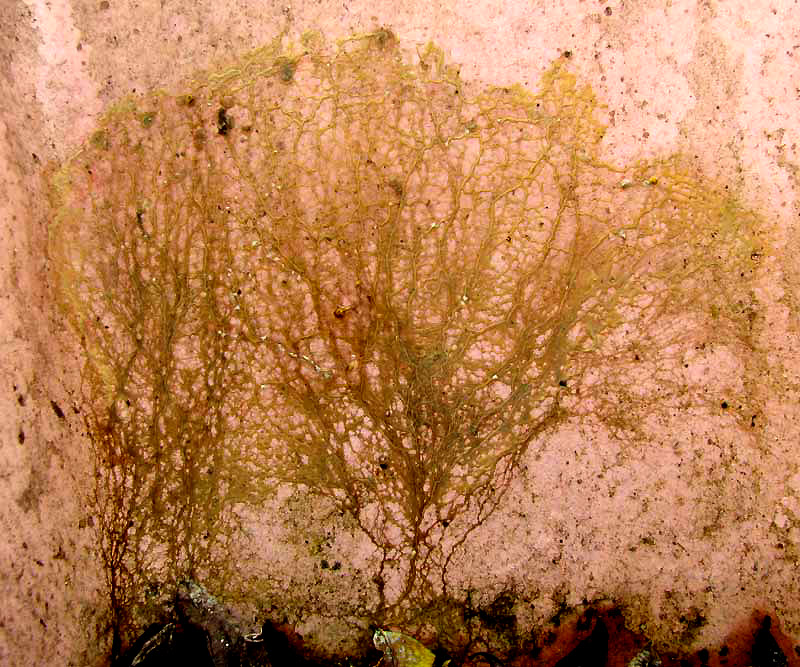
from the December 4, 2011 Newsletter issued from Hacienda Chichen Resort beside Chichén Itzá Ruins; limestone bedrock; elevation ~39m (~128ft), N20.675°, W88.569°; central Yucatán state, MÉXICO
SLIME MOLD IN THE WASH BASIN
Here at the beginning of the dry season leaves are falling, collecting in odd places, moldering, lending an air of seedy repose everyplace not swept on a daily basis. Leaves gather in my outside bathroom's corners, nightly dews soak them and en masse each afternoon they dry into a brown crust like a layer of burnt oatmeal in the bottom of a pot. You can see such encrustations in the bottoms of troughs of the clothes-washing station next to my pole-walled shower below:
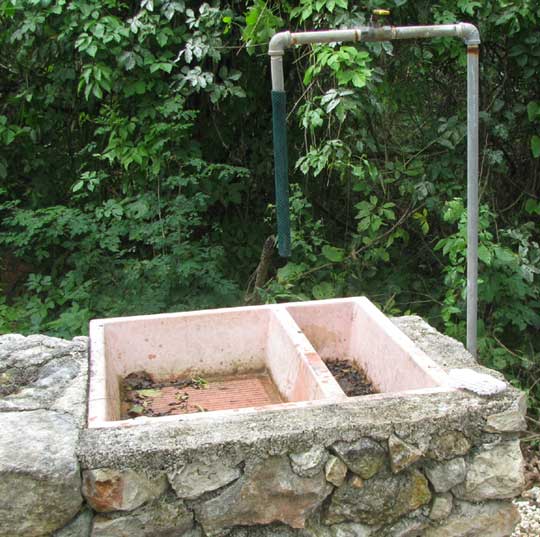
In that picture, in the narrow trough on the right, on the back wall and toward the lower left, do you see that vague, wedge-shaped stain? That smudge is shown up close at the top of this page.
That whole treelike structure is four inches tall (10cm). It originated in soggy, decaying leaf litter on the trough's floor and spread up the near-vertical wall, branching and rebranching as it went, the branches often reconnecting with one another, forming an intricate, even beautiful, network. At the branches' uppermost tips the ramifications have thickened and occasionally budded into tiny mounds. You can see a much-enlarged photo of one of the topmost strands showing a budding tip below:

This is one of the Earth's most poorly understood, even mysterious, life forms. It's not a plant, not an animal, not a fungus. In fact, there's much debate about what taxonomic kingdom it belongs to. In common terms we can say that it's a slime mold, possibly PHYSARUM POLYCEPHALUM. I pick that name only because the picture matches others of that species found on the Internet, and the species seems to commonly occur. However, there are lots of species in the genus Physarum, and many, many slime mold genera and families.
The fan-shaped item in the picture is the resting stage of the vegetative form, which is known as a plasmodium. Plasmodia are thought of as single, huge cells invested with only one membrane, yet containing within that membrane very many nuclei, which stream along with the cell's protoplasm as the plasmodium grows searching for food. The plasmodium surrounds its food and secretes enzymes to digest it.
If the streaming plasmodium dries out it forms a sclerotium, which is the hardened, immobile thing shown in our picture. The sclerotium can remain in this dormant stage for a long time. Once favorable conditions resume, it will soften and continue growing and wandering, looking for food.
If the food supply runs out, the plasmodium stops feeding and enters a reproductive phase. Stalks of spore-producing sporangia form; I assume that the volcano-like feature shown in the last photo is a sporangium. Spores are spread by wind. They can remain dormant for years.
When environmental conditions are favorable, spores germinate and release either microscopic, tail-bearing, or "flagellated," cells, or else microscopic, amoeba-like "swarm cells," which eventually fuse together to form a new plasmodium.
Don't let that information slide by you. It means that during the slime mold's life history, sometimes it's actually many independently living organisms moving about, but then those many things combine to form just one organism, the plasmodium. It's as people in a street crowd suddenly began merging with one another, eventually ending up as one enormous, wandering, hungry being.
The mysteriousness doesn't stop there. Physarum polycephalum's plasmodium has been documented doing certain things that simple organisms aren't supposed to be able to. For example, by repeatedly alternating a plasmodium's environment between cold and hot at 60- minute intervals, biophysicists at Japan's Hokkaido University found that the slime mould appeared to react on time even, anticipate the pattern, when the researchers didn't repeat the conditions for the next interval. The plasmodium somehow had "learned" to prepare for the coming change.
Plasmodia connect their many branches into networks capable of distributing resources among their parts as efficiently as roads in human cities. This has caused some experts to consider them the "ideal substrate for future and emerging bio-computing devices."
References to these and other studies on Physarum polycephalum can be found on its Wikipedia page at https://en.wikipedia.org/wiki/Physarum_polycephalum.
I've resolved to not clean out the right side of my clothes-washing station. My pleasure in having a Physarum polycephalum plasmodium sclerotium waiting there for the next rainy season outweighs any service the trough could provide.
from the January 1, 2012 Newsletter issued from Hacienda Chichen Resort beside Chichén Itzá Ruins; limestone bedrock; elevation ~39m (~128ft), N20.675°, W88.569°; central Yucatán state, MÉXICO
SLIME MOLD FRUITING BODIES
I'm beginning to think that this is the right time of year -- the early dry season -- to look for slime mold fruiting bodies. During the rainy season slime molds must creep unseen through leaf detritus, up perpetually moist walls, and such, and now that rain has all but disappeared the dryness is stressing them, causing them to reproduce.
For slime molds producing plasmodia, the reproduction process begins with the plasmodium stops wandering and fractures into many small, scattered units. Each individual unit then develops a fruiting body, or stalked sporangium, which is where spores are produced. It's those stalked sporangia I'm seeing now.
For example, near the hut a certain pile of firewood needing to be split has been lying in a dank, shady spot beneath a Ceiba for so long that the pieces are beginning to decay. You can see part of that pile, with a slime mold's stalked sporangia appearing as clusters of tiny white spots on log ends -- as in the lower right and left corners in the picture below:
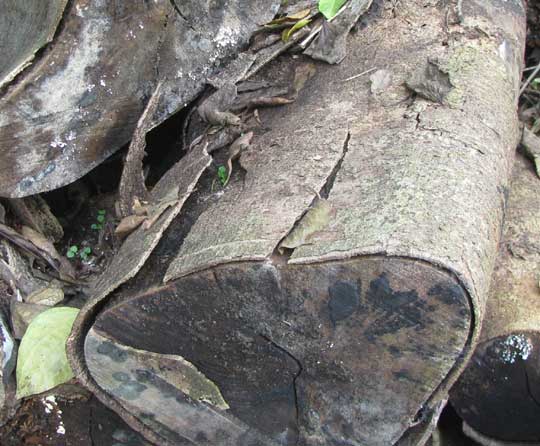
A close-up of some stalked sporangia, which tend to droop downward from their points of attachment below:
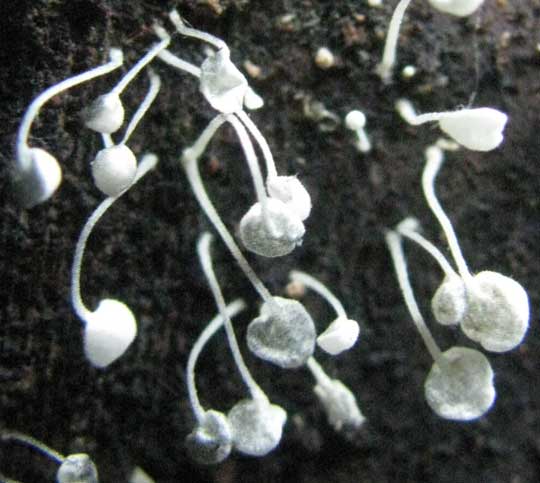
A close-up of a single stalked body, the largest one I could find, on a ruler graded in millimeters is shown below:
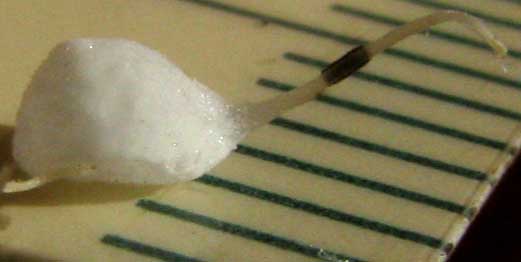
That sporangium's white head is about 3mm tall (1/10th inch). The heads aren't mature yet. When broken open, inside they're like diffuse white cotton.
A couple of logs away grew another little slime mold colony of a different species, as shown below:
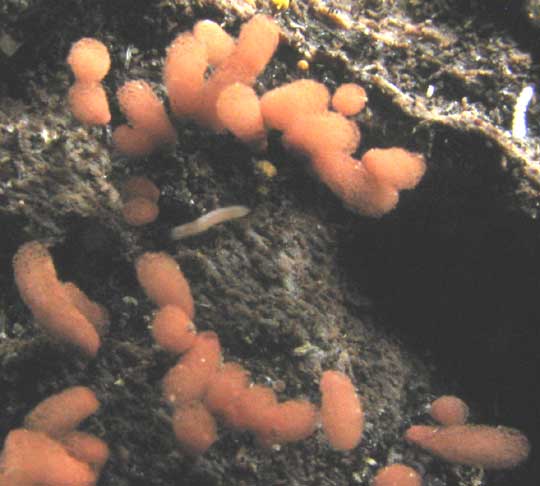
These heads were smaller still, only about 2mm tall.
I have no idea what species these are. I read that identification of sporangia to species level is only possible when the sporangia are mature. Then they're likely to develop distinctive colors, and internal features that show up under a microscopic.
from the April 10, 2016 Newsletter issued from Hacienda Chichen Resort beside Chichén Itzá Ruins, central Yucatán MÉXICO
SLIME MOLD FRUITING BODIES ON THE HUT'S WALL-POLES
In the hut, my computer sits on a table next to a pole wall. On the hottest afternoons nearly always a little breeze passes between the poles, keeping the computer and me cooler than outside. To rest my eyes or to gather thought, often I look between the poles at the world outside. Sometimes birds hop on the ground right below me, or a big iguana rambles through with bulging throat pouches. Below, you can see the wall at my head level:

In that picture where light streams in from outside, between some of the poles you can barely see tiny, slender, blackish, little match-stick-like things projecting into the openings perpendicularly from the poles. A close-up of some of those items is shown below:
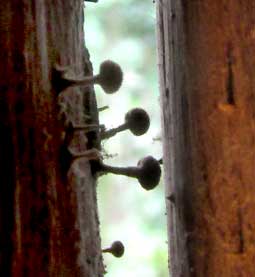
They look like very tiny mushrooms, but they're not a kind of fungus at all. They're dried-up slime mold fruiting bodies waiting for wet weather. Slime molds aren't fungi, aren't plants and aren't animals. They belong to a kingdom of organisms called protists. They have complex life cycles that can include an animal-like phase during which it moves around under rotting logs, damp leaves and such, feeding and growing, and a plantlike reproductive phase during which it stays in one place, like those on the hut's pole walls.
issued on November 29, 2019 from near Tepakán, Yucatán MÉXICO
ORANGE, WORM-POOP-LIKE SLIME MOLD
At the end of our rainy season, when the forest floor was at its peak of water-saturation for the year, something orange colored turned up on the forest floor looking at first like coils of earthworm poop, other than its being bright orange, as shown below:
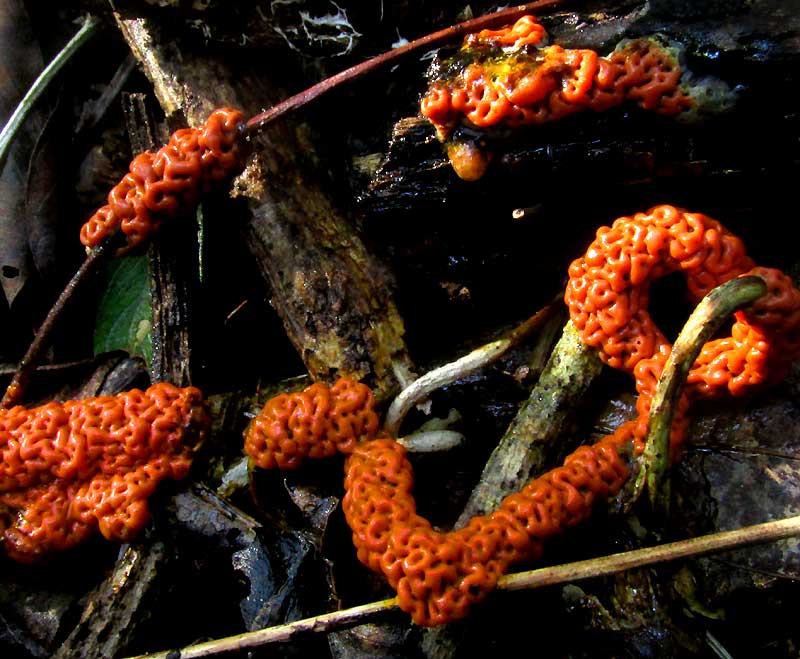
The objects' bodies seem as if they were made of strings of crammed-together tiny orange doughnuts. However, at the above picture's top, a little in from the top-right corner, notice the spot where the doughnuts appear to have liquified. A close-up of that area appears below:
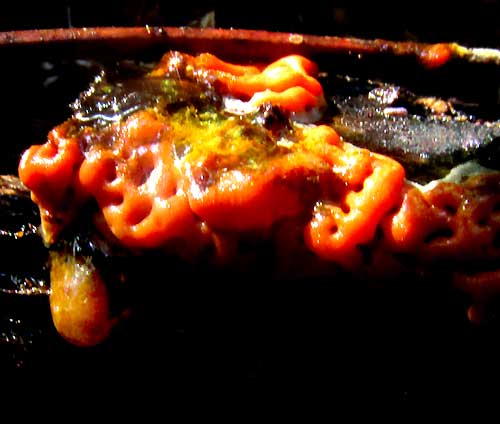
I'd hesitated to declare this to be a slime mold until I saw that, suggesting to me that maybe the orange bodies might be sclerotiums produced by plasmodia. On the Internet I find similar but not identical orange bodies that others have identified as slime molds. However, I'm not at all sure that this is indeed a slime mold. I'll just park the pictures here and hope that someday a specialist comes along with more insight.